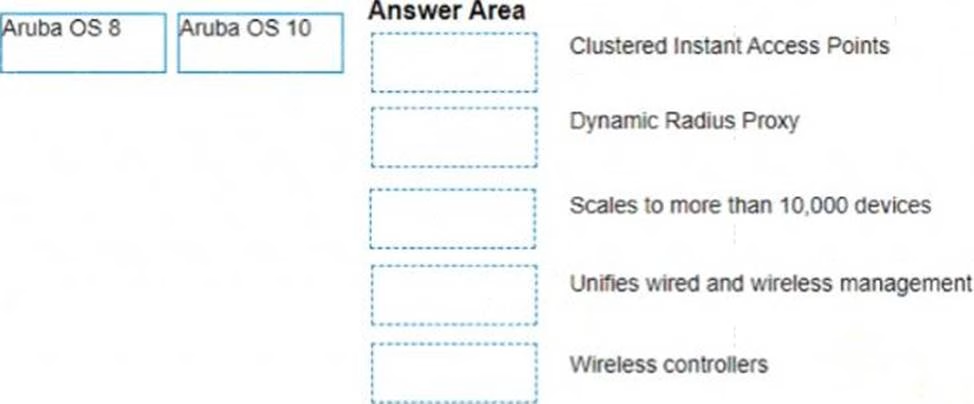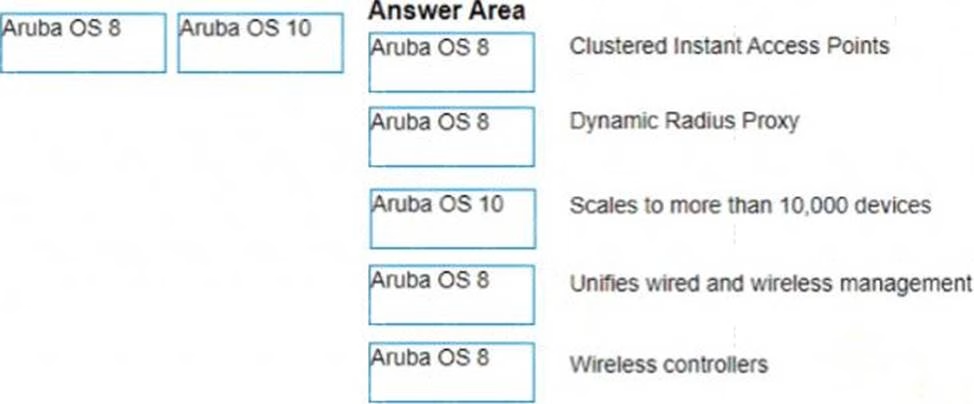Match the feature to the Aruba OS version (Matches may be used more than once.)
Match the feature to the Aruba OS version (Matches may be used more than once.)

Answer: 
Explanation:
Features: 1) Clustered Instant Access Points Aruba OS version: a) Aruba OS 8
Features: 2) Dynamic Radius Proxy Aruba OS version: a) Aruba OS 8
Features: 3) Scales to more than 10,000 devices Aruba OS version: b) Aruba OS 10
Features: 4) Unifies wired and wireless management Aruba OS version: a) Aruba OS 8
Features: 5) Wireless controllers Aruba OS version: a) Aruba OS 8
ArubaOS is the operating system for all Aruba Mobility Controllers (MCs) and controller-managed wireless access points (APs). ArubaOS 8 delivers unified wired and wireless access, seamless roaming, enterprise grade security, and a highly available network with the required reliability to support high density environments1.
Some of the features of ArubaOS 8 are:
– Clustered Instant Access Points: This feature allows multiple Instant APs to form a cluster and share configuration and state information. This enables seamless roaming, load balancing, and fast failover for clients2.
– Dynamic Radius Proxy: This feature allows an MC to act as a proxy for RADIUS authentication requests from clients or APs. This simplifies the configuration and management of RADIUS servers and reduces the network traffic between MCs and RADIUS servers3.
– Wireless controllers: Aruba wireless controllers are devices that centrally manage and control the wireless network. They provide functions such as AP provisioning, configuration, security, policy enforcement, and network optimization.
ArubaOS 10 is the next-generation operating system that works with Aruba Central, a cloud-based network management platform. ArubaOS 10 delivers greater scalability, security, and AI-powered optimization across large campuses, branches, and remote work environments. Some of the features of ArubaOS 10 are:
– Scales to more than 10,000 devices: ArubaOS 10 can support up to 10,000 devices per cluster, which is ten times more than ArubaOS 8. This enables customers to scale their networks without compromising performance or reliability.
– Unifies wired and wireless management: ArubaOS 10 provides a single platform for managing both wired and wireless devices across the network. Customers can use Aruba Central to configure, monitor, troubleshoot, and update their devices from anywhere.
Both ArubaOS 8 and ArubaOS 10 share some common features, such as:
– Unifies wired and wireless management: Both operating systems provide unified wired and wireless
access for customers who use Aruba switches and APs. Customers can use a single interface to manage
their entire network infrastructure1.
References:
1 https://www.arubanetworks.com/resource/arubaos-8-fundamental-guide/
2 https://www.arubanetworks.com/techdocs/Instant_86_WebHelp/Content/instant-ug/iap-maintenance/clus
3 https://www.arubanetworks.com/techdocs/ArubaOS_86_Web_Help/Content/arubaos-solutions/1-overvie
https://www.arubanetworks.com/products/networking/controllers/
https://www.arubanetworks.com/products/network-management-operations/arubaos/
https://blogs.arubanetworks.com/solutions/making-the-switch/
https://www.arubanetworks.com/products/network-management-operations/aruba-central/
Latest HPE6-A85 Dumps Valid Version with 60 Q&As
Latest And Valid Q&A | Instant Download | Once Fail, Full Refund

